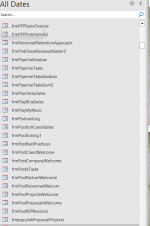- Local time
- , 23:41
- Joined
- Feb 28, 2001
- Messages
- 31,030
As I have said, splitting it is out. Ask Colin. It just ain't going to happen on my watch.
Yes it will... IF you realize that by splitting the DB, you can break the 2 GB barrier in virtuo IF there are sufficient points of division between the tables.
If you have two non-overlapping subsets of tables that never have to involve a relationship between them, then you can have multiple back-ends, EACH of which can be over 1.8 Gb. AND the FE can also get big, with your "thousands of reports and forms." But by splitting, you negate the problem of space occupied by forms and reports that take away from table space in a monolithic database - because you can have up to 16 DB files linked together - 1 FE and a bunch of back ends. Meaning that with careful splitting, and if the app allows it, you can reach as many as 16 x 1.8 Gb or about 28.8 Gb total space. (This is an idealized limit.) No table could ever exceed 2 Gb either way you cut it. You cannot have a single query with a recordset bigger than 1 Gb (according to the Access specifications) so your queries will necessarily limit your size. Other limits tell me that you really don't have much code in your system because you can't have more than 1000 modules - and that includes class modules associated with forms and reports, which you say number in the thousands as well.
And as to commercializing this monster, I will say "good luck to you" but anyone who understands database design KNOWS that you need to split things up because that gives you the ability to optimize layouts and minimize data loss. If multiple disks are available, splitting the back ends over more than one disk allows you to have parallel seek latency.
The only MAJOR thing you lose if you split a database into multiple back-ends is that you cannot establish a relationship between two tables in different files, because the system relationship table doesn't have a "back-end" number in it. Which means no relational integrity between tables in different files. But with thousands of tables, I would have trouble imagining that ALL of them have RI enabled anyway.


